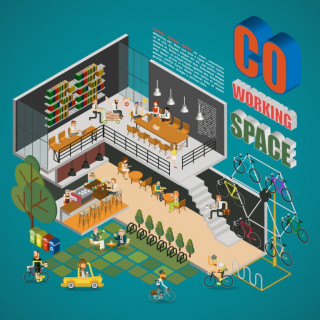This year is the 10th anniversary of my decision to devote myself to the creation of the models of social changes. After banging my head against the wall, trying to scale the default coworking business model, I realized that only city-wide catalyst models such as smart city can survive and are ones of the pillars of the future of coworking business as well as cities itself.
It took some time when I tried to persuade the atomized community of small coworking owners that our model will not sustain and will probably end up very, very soon, but they didn’t want to listen. Next year, the network of publicly financed spaces turned up into business, disrupting the co-working space in every major city.
It was 2011, but of course, it was yet not what is coming now, when the main international networks are opening a multitude of huge spaces in the capital cities, using deep pockets of VC bankers and property managers and owners.
Warm, organic community growth generated by its leaders — it’s time to say goodbye. The future is in large corporate global coworking behemots.
Well, I foresighted that too. But in fact, the problem of coworking and the growth of these amazing communities (in Poland) lay somewhere else, than a lot of people think, and I hope I’m right on this. Poland is brain-drained, and the number of freelancers and creatives on the market is not growing, but even decreasing!
The problem can stand like this: how to encourage the average tee drinking person (from outside of creative industries) to fill all of the new transformed places? In other words: how to make people learn and become creative for the purpose of office rental to grow?
Introducing serious gaming can be one of the solutions. In Poland, we developed a complex model of how to get secondary schools and technical schools’ students on board of smart city and into the creative industry but it’s for another story.
In some cities, the important issue is how to not rent buildings to corporate employees, but how to use the growing number of freelancers, digital nomads and creative industries to fill new floors in new, sophisticated buildings and even neighborhoods.
We need to rethink that on a big scale. What you do not see in the small business sheet, is what large operators see. And they are making the impact right now.
The revolution will soon come over how the city is treated, used and perceived. For more and more people, city spaces become a meeting platform where they share time for creative activities with other people. As a reminder, for most of us, city streets are still the means of the fastest transfer between work and home and visiting many strange offices in order to get along with life in the so-called society. But this era is going to the end according to Toffler theory of The Third Wave. (and many others).
Reality changes quickly and aims to transform most experiences according to new paradigms and new reality. When we talk, new technologies “eat” workplaces and administrative bodies one by one. The new reality is about convergence, experience, sensitivity to all activities related to science and useful society or urban activities.
Step by step, engaging people in new social models such as coworking, as well as smart city, we as frontier innovators introduce expectations to a whole new level for the citizens. And imagine how competitive the city will be, after being completely reorganized to facilitate the coworking culture in its all places and spaces. The new intelligent digital layer of the social city will finally emanate in different forms.
The most important coworking values: community, cooperation, openness can be a great foundation for building other smart city solutions on it.
At this point, I really want to encourage the coworking and startup community to cooperate with municipal offices to facilitate and promote new socio-economic models, such as cooperation platforms, sharing economy and social entrepreneurship.
Why it’s so important?
In July 2011, Mitsui Fudosan announced its new concept, Kashiwa-no-ha Smart City, based on three pillars: environment symbiosis, health and longevity, and creation of new industry.
Gate Square, which serves as the center of the smart city and brings together offices, residences, retail space, a hotel, and academic facilities, encourages interaction among the residents of the area, as well as those who commute to the city to work. (@Mitsui Fudosan Co., Ltd. )
The city’s perspective offers access to all taxpayers, and all this means that communication takes place in all urban social groups. At the same time, there is no way for city administration by themselves to adapt to the new disruptive innovation in enough fast pace because of the development opportunities have always will be stalled in administrative and budgetary never-ending processes.
The line of cooperation between city halls and coworking and startups must be marked. If they all have an impact, cities can grow well and live fully. But what exactly is a smart city? it is about citizens in all aspects of their lives and development using the latest technological advances, as well as methods for integrating and empowering people to take the driver seat in cities.
So what concerned me and what I’m talking about in the Smart City Podcast is that if, in fact, startups offering services to their citizens are often placed in coworking. So I assumed what the future role of this community for the city might be of great importance. Recognizing the positive effect of gathering creative people in post-industrial districts in order to revitalize it gives me hope that the urban strategy will eventually include a systematic approach to support and benefits for local communities.
But it is not what always happens. In most cases the positive effect of this coalition is consumed by private business not the city itself.
There is still a clash between the old-fashioned archaic hierarchy and the partial approach to city management, and new grassroots impulses. The new urbanists concepts are about driving development through the combination of ideas, products that enable the crowd’s wisdom in creating the city. So-called smart city 3.0 approach. But what cannot be combined in an old paradigm with only an improvement called sometimes “creative” or “smart” can be combined into a completely new model of an intelligent city, and ultimately it will replace those catching up and still converting cities.
What is to come is, of course, standardized as a framework for programming applications for “i-stores” and “app markets” for city creators and visionaries. It is not possible to maintain the basic needs of citizens’ tools based on a certain form of capitalist/market-oriented intermediary operating from the sky and oceans. Everything will be brought to local clouds and as close as it can be to the community of people adopting these independent standards, these standards will be introduced at the EU level or at the global level.
The re-orientation of the use of common communication / technology platforms and the emergence of new interfaces will also be achieved thanks to new data transfer standards (such 5G) and a fundamental change of the current system’s pillars, such as financial transactions (Fintech), as well as fluid law enforcement and liquidity through blockchain, as well as distributed and reliable databases.
Imagine what will happen if all applications are just a larger complex system that will allow cities to do just better. And I do not want to issue a label — or a brand for it (if I may i’ll name it City2.0neOS) Certainly the aggregation and the process of setting standards for cities can be a process that will end with a completely new ecosystem for innovation and unveiling our living to the fullest, and this is what it is all about.
SpaceOS is a smart technology, creating smart buildings and smart offices by letting workspaces turn the physical spaces into digital assets.
So in my opinion, a new model of cities based on a foundation of Open Source idea (Github and Linux are the greater examples) will be created. It will be standing on the values that create a coworking movement, and this model will be a combination of well-known solutions and applications in a standardized interurban form that will be developed by the community for its own purposes and best interests. And what’s best this movement is vibrant and alive and it’s happening all over the world. I hope in my best will that in the best solution and it is unstoppable and impossible to reverse.
Write to me if you want to learn more about the idea of a coworking city!





